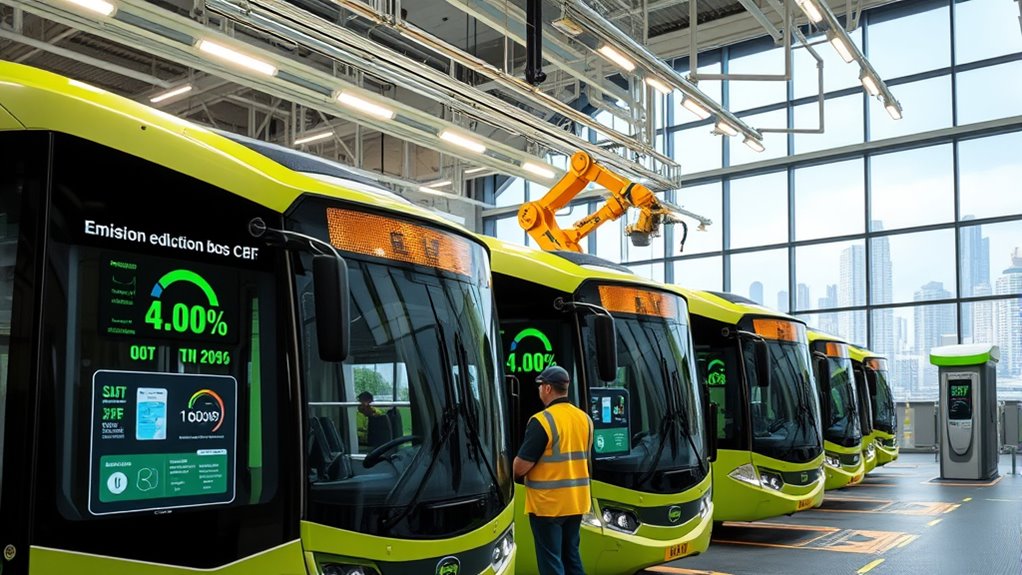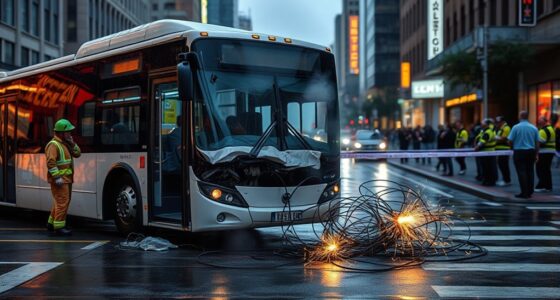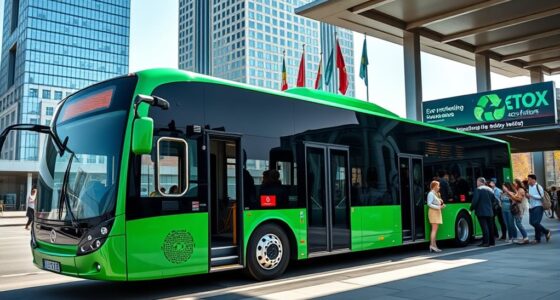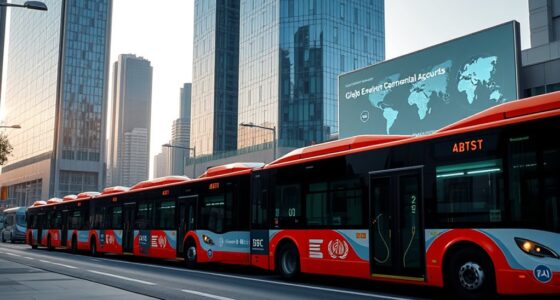ZEV mandates are pushing bus manufacturers to accelerate electric bus production and adopt innovative technologies. You’ll see them expanding manufacturing capacity to meet strict quotas, often investing in new facilities. These policies lower costs through economies of scale, making electric buses more affordable. They also drive advances in batteries, charging infrastructure, and design. If you want to explore how these regulations shape the industry’s future and the opportunities they present, there’s more to discover ahead.
Key Takeaways
- ZEV mandates compel manufacturers to scale up electric bus production, driving industry transformation and capacity expansion.
- Increased demand lowers costs through economies of scale, making electric buses more competitive and expanding market share.
- Mandates foster innovation in battery tech and charging infrastructure, improving bus performance and energy efficiency.
- Regulatory requirements pressure manufacturers to meet strict quotas, with penalties for non-compliance, influencing strategic planning.
- The policies promote industry-wide shift toward sustainable transportation, encouraging investments and technological advancement.

Have you ever wondered how zero-emission vehicle (ZEV) mandates are transforming the bus manufacturing industry? These policies compel manufacturers to markedly ramp up production of electric buses, creating a huge shift in capacity and supply chains. As a result, you’re pushed to expand your manufacturing capabilities to meet the increasing demand for cleaner transportation options. The mandates enforce strict quotas that require compliance, even when producing electric buses isn’t yet the most financially attractive option. This pushes your industry toward a large-scale transformation, emphasizing electric mobility and setting new standards for sustainability.
Look to successful examples from China and Europe, where such mandates have proven effective, and recognize that these regions are paving the way for global change.
China and Europe lead the way in ZEV mandates, setting global standards for electric bus adoption and industry transformation.
Economically, the push to produce more electric buses under ZEV mandates can lead to cost reductions over time. As production scales up, you’ll benefit from economies of scale, which help lower manufacturing costs. This, in turn, can make electric buses more affordable and accessible, expanding your market share.
Mandates can also incentivize investments in local manufacturing facilities, fostering economic growth and creating jobs within your community. However, failing to meet quotas could result in fines or the need to purchase credits from compliant manufacturers, adding financial pressure to stay on track. These policies spark innovation within your industry, encouraging your teams to develop advanced electric bus technologies that meet regulatory standards and customer expectations alike.
The need to innovate often results in better-performing buses with longer ranges and improved energy efficiency, further boosting your competitive edge and encouraging market expansion.
From an environmental perspective, ZEV mandates align your industry with global sustainability goals. Electric buses emit zero tailpipe emissions, drastically improving urban air quality and public health. They contribute to reducing greenhouse gases, helping your region meet climate commitments and sustainability targets.
These policies also ensure your manufacturing practices stay in line with stricter environmental regulations, promoting cleaner industry standards. As a result, communities benefit from better air quality, fewer pollutants, and healthier populations.
Technologically, these mandates drive innovations like enhanced battery performance, expanded charging infrastructure, and new, more efficient bus designs. You’re encouraged to share technological advancements with other companies, accelerating progress across the industry.
Improved energy efficiency and innovative designs not only meet regulatory standards but also cater to consumer preferences, making electric buses more attractive and practical.
Finally, the regulatory framework supporting ZEV mandates requires legislative backing to guarantee compliance. As a manufacturer, you rely on clear policies and enforcement mechanisms to guide your transition.
This framework helps create a level playing field, ensuring fair competition while supporting your shift toward cleaner, sustainable transportation solutions. Overall, ZEV mandates are reshaping your industry—driving production, innovation, and environmental responsibility—and setting the stage for a future where electric buses become the norm rather than the exception.
Frequently Asked Questions
How Do ZEV Mandates Influence Bus Manufacturers’ R&D Investments?
ZEV mandates push you to ramp up R&D investments, focusing on new battery tech, efficient powertrains, and sustainable systems.
You’ll prioritize reducing costs and improving manufacturing processes to stay competitive.
These mandates also encourage you to develop innovative solutions aligned with environmental policies, expand production capacity, and form strategic partnerships.
Ultimately, your R&D efforts aim to meet regulatory standards, lower costs, and capture market share in the growing electric bus industry.
What Are the Long-Term Economic Impacts of ZEV Mandates on Bus Companies?
You might wonder about the long-term economic impacts of ZEV mandates on bus companies. In the future, you’ll see lower operational costs due to savings on fuel and maintenance, boosting profitability.
While initial investments are higher, technological advances and subsidies will ease costs. Market demand will grow, giving you a competitive edge.
Ultimately, embracing ZEVs positions you for sustainable growth, aligning profits with environmental responsibility.
How Do ZEV Mandates Affect Bus Fleet Maintenance and Operation Costs?
You might notice that ZEV mandates can lower your bus fleet’s maintenance costs because electric buses have fewer moving parts, reducing repairs and routine service like oil changes.
Regenerative braking cuts brake wear, and simplified drivetrains make maintenance more predictable.
While upfront costs are higher, your fuel expenses drop markedly, and overall operation becomes more efficient.
These factors can help you save money in the long run, despite initial investments.
Are Smaller Bus Manufacturers Better Positioned to Adapt to ZEV Regulations?
You might think smaller bus manufacturers are better positioned to adapt to ZEV regulations because of their agility and niche focus. They can innovate faster and customize solutions for underserved markets.
However, they face significant challenges like high costs, limited economies of scale, supply chain issues, and funding dependence.
While some advantages exist, overall, smaller firms must navigate substantial financial and operational hurdles to meet evolving ZEV standards effectively.
What Are the Potential International Implications of ZEV Mandates on Global Bus Markets?
You might think ZEV mandates only affect local markets, but they actually reshape global bus trade substantially. These regulations push manufacturers worldwide to innovate faster, creating new export opportunities for early adopters like China and Europe.
They also encourage harmonized standards, reducing trade barriers, but may increase certification costs for smaller firms. Overall, ZEV mandates accelerate technological shifts, influence supply chains, and foster intense international competition.
Conclusion
While ZEV mandates aim to revolutionize transportation, they often push bus manufacturers into uncharted territory, forcing innovation at a breakneck pace. Ironically, in aiming for cleaner skies, you might find yourself charting a maze of compliance and technological hurdles. Instead of smooth sailing, these mandates turn your industry into a high-stakes test lab, proving that sometimes, the road to a greener future is paved with unexpected challenges—and a little bit of irony.









